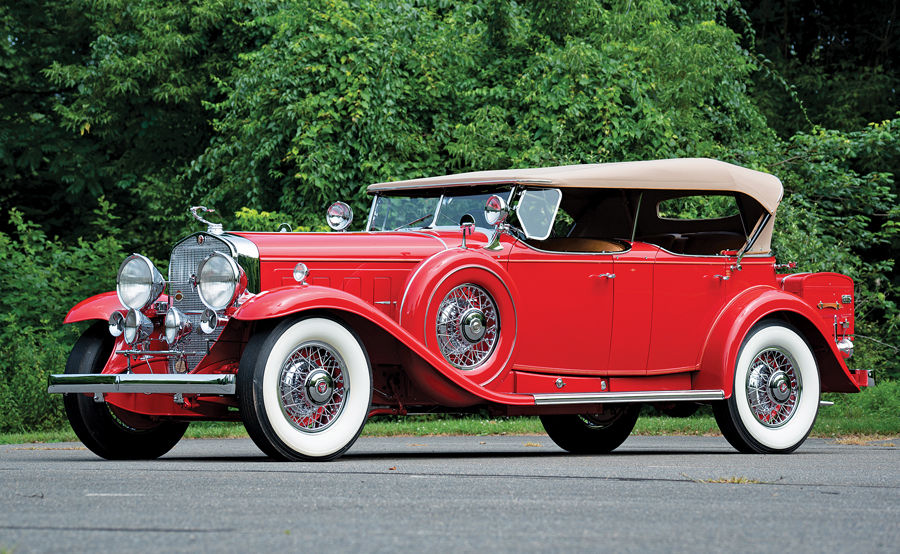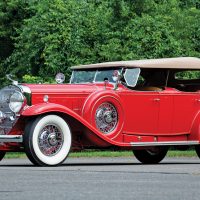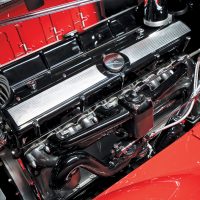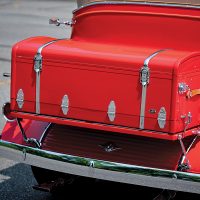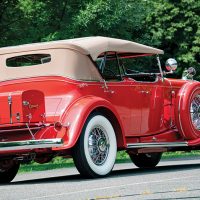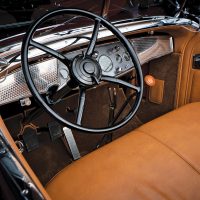SCM Analysis
Detailing
| Vehicle: | 1930 Cadillac V16 Sport Phaeton by Fleetwood |
| Years Produced: | 1930 |
| Number Produced: | 85 |
| Original List Price: | $6,500 |
| SCM Valuation: | $1,221,000 (this car) |
| Tune Up Cost: | $1,400 with distributor caps |
| Chassis Number Location: | Right side of crankcase near water inlet |
| Club Info: | Classic Car Club of America |
| Website: | http://classiccarclub.org |
| Alternatives: | 1930 Packard 740 sedan, 1930 Pierce-Arrow Model A sedan, 1930 Stutz MB |
| Investment Grade: | B |
This car, Lot 417, sold for $1,221,000, including buyer’s premium, at RM Auctions’ Hershey Lodge Auction held in Hershey, PA, on October 11, 2019.
Most SCM readers know that Henry Leland left Cadillac to form Lincoln. What they may not know is that Leland had left Oldsmobile to help form Cadillac.
Well, he was not actually working for Oldsmobile, but his firm supplied the three-horsepower motor for the curved-dash Olds. Leland was able to more than triple the horsepower, but Oldsmobile was not interested.
The investors in Henry Ford’s defunct Detroit Automobile Company were, however, convinced of the viability of the engine, and the Cadillac Automobile Company was formed in 1902.
The new, innovative firm prospered. In 1909, it became part of William Durant’s General Motors. Fast-forward to 1917, and the United States was entering Word War I in Europe. Leyland suggested to Durant that Cadillac build aircraft engines, but Durant, a pacifist, wanted no part of the war effort.
Leyland, in turn, went to Washington and was assured that they would be awarded a contract for building the engines. Returning to Detroit, Leyland resigned and quickly founded the Lincoln Motor Company.
In the ensuing years, Cadillac competitors Packard, Stutz, Duesenberg and Pierce-Arrow made inroads into the luxury-car market — once Cadillac’s sole purview. Perhaps it was the absence of Leyland’s leadership, but Cadillac had lost its innovative edge.
Cadillac’s V16 engine
In 1926, in a secret “skunk works” environment, Cadillac began work on an innovative new V16 powerplant. The project was so protected that internal communications referred to it as a “bus” or “coach” project.
The resulting engine, introduced in 1930, was an elegant work of art — and one of the few engines ever produced to have been styled. Wires were channeled inside the valley between the two cylinder banks and concealed by a black enameled cover that matched the rest of the engine.
The 452-ci engine produced 165 horsepower and was essentially two straight-8 blocks, each having its own fuel-feed and ignition systems. This allowed for the driver to switch off one entire bank and cruise on the other 8. This was an idea that resurfaced in 1981 with the short-lived Cadillac V-8-6-4.
In 1930, Cadillac buyers could choose from an imposing 72 body styles — in addition to uncataloged custom coachwork offerings. Only 85 dual-windshield sport phaetons were produced on the 148-inch wheelbase chassis. It was one of the least-expensive V16s offered, with a catalog price of $6,500. It was an age of opulence done to perfection with little regard to cost.
Hollywood history
Our featured Cadillac has often been referred to as the Alan Ladd Cadillac, as he drove it in the film “The Carpetbaggers,” in which he played Nevada Smith. The car suffered the indignity of being customized with white calfskin upholstery, pistols for door handles, a rearing-horse hood ornament and a set of longhorns mounted in front of the radiator.
Fortunately, it was returned to its former glory after filming ended.
Early movie star Richard Arlen was the car’s first owner. Arlen starred in “Wings,” which won the first-ever Academy Award for Best Picture.
As the story goes, Arlen went to the Don Lee Cadillac Agency in Los Angeles to decide if he wanted the car. Movie star Mae West, an early sex symbol, was sitting in the car and informed him that if he did not buy the car, she would. He quickly made the deal.
A big sale in a dropping market
This stunning sport phaeton was fitted with dual sidemount spares, a low-profile rear trunk, rear-seat instruments, a roll-up division window and special “veed” front windshield.
Slightly cut-down doors and a long hood emphasized the long, dramatic body. This car personified the Classic Era.
This Cadillac sold for a strong number in a questionable market, but I have long stated that the cream rises to the top, and exceptional offerings will continue to bring the money.
I doubt that “star power” had much to do with the final price, as few people remember Alan Ladd — let alone Richard Arlen. This car stood on its own merits. The strong price was well deserved and was market-correct. ♦
(Introductory description courtesy of RM Auctions.)
